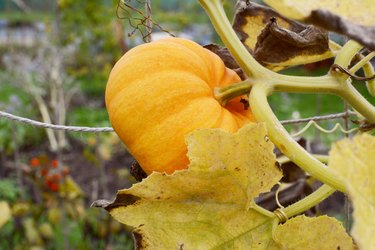
Christmas is associated with evergreens and holly, Valentine's Day means hearts and chocolate, and Halloween is linked with pumpkins. Both the young and old look forward to carving pumpkins into jack-o'-lanterns with cut-out eyes, nose, and mouth lit up from the inside of the pumpkin shell with a candle.
If you are looking for a fun, entertaining, and adventurous project for this holiday, act now! You still have time to plant mini pumpkins (Cucurbita pepo) in your garden bed or in containers. Unlike the standard pumpkin, these mini fruits can go from seed to harvest in a little over 2 months. They're great for Halloween and are also perfect for Thanksgiving and Christmas decor and feasting.
Video of the Day
Video of the Day
Pumpkins and Halloween
Most kids who celebrate Halloween include carving pumpkins in their holiday preparation. Creating these jack-o'-lanterns is a yearly Halloween tradition in the United States thanks to immigrants from Ireland who brought the practice with them. Whole pumpkins and carved jack-o'-lanterns are common decorations indoors and outdoors around Halloween.
For gardeners who get started early, growing Halloween regular-size pumpkins in a large backyard garden is entirely possible, but it takes some varieties 4 months from seed to harvest, not to mention that they need lots of space for the pumpkin vines to sprawl out. But mini pumpkins need a lot less space, and some mature in as little as 70 days.
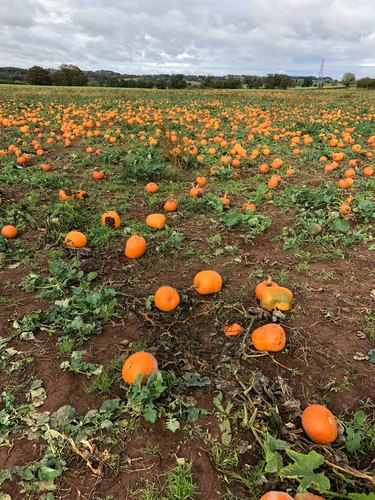
All About Mini Pumpkins
"Mini" versions of things always seem to be trending, from mini pit bulls to Mini cars to mini pumpkins. There is just something cute and appealing about things that are considerably smaller than normal. And when it comes to mini pumpkins, though they are smaller, there is so much more to love.
What are mini pumpkins? They are little pumpkins that weigh 4 pounds or less and often are under a pound. There are many varieties with different growing seasons and different growth patterns: some vine, some grow into bushes, and many grow nicely in a large container on the patio.
These adorable mini squashes are wonderful for Halloween decor or Thanksgiving centerpieces, but they are also sweet, tender, and delicious in holiday recipes. The time to plant them is: RIGHT NOW!

How to Grow Miniature Pumpkins
Mini pumpkins are fun and easy to grow, and if you get started in late July, you can have ripe pumpkins by Halloween. If you wait a few weeks, they may still be on the vine at Halloween and can be part of your Thanksgiving celebration. Kids really love this project, and one pack of seeds will provide enough for a whole pack of children — and you!

1. Pick your pumpkin
The first step in growing a mini pumpkin is to pick a seed variety. There are lots of choices and many factors to consider. Be sure to check the time to maturity. For my own experiment for this article, I chose Jack Be Little and Sugar Pie. I was planting in early July, so the 70- to 90-day maturity period was just fine.
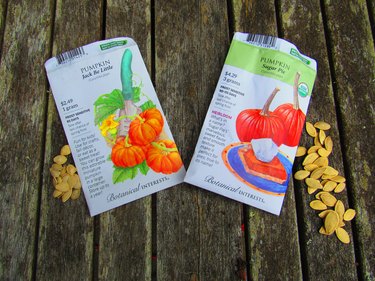
2. Set up a container or site
You can grow miniature pumpkins in 5-gallon containers that are at least 18 inches deep or else in a sunny garden bed. At least 6 to 8 hours a day of direct sun is recommended. The soil that works best is good-quality potting soil amended with several inches of organic compost. Add some slow-release organic vegetable fertilizer before planting.
3. Set up the trellis or stakes
If you are growing vining plants (as opposed to bush plants), set up a trellis in the container or bed. This lets you grow the plants vertically. In the garden, I like to use a large piece of wire mesh panel, attaching it to supports at the back of a raised bed. In containers, I use tomato stakes, installing them when the vines are long enough to need them.
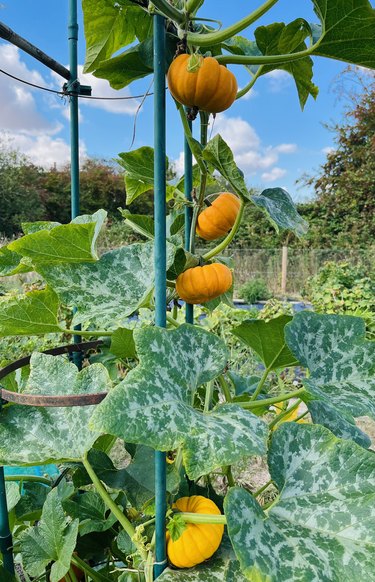
4. Plant the seeds
Whether you are planting in the garden bed or in a container, mound the soil for each plant. I can only fit one mound in a container, but in a garden bed, there is room for more. You should space them 8 to 12 inches apart.
Plant two or three seeds in each mound. Each seed should be planted about 1 inch deep. Water after planting.
5. Watch for growth
Once the seeds are planted, keep the soil moist but not wet. You will see leaves emerging after a week or two weeks at most.
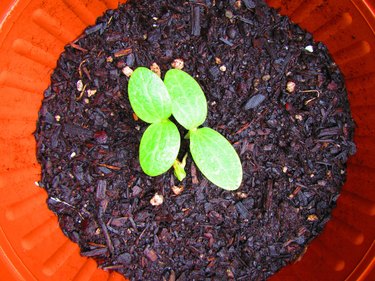
Once the seeds germinate, the plants grow quickly in a sunny location. Check them every day and give them water when dry. When the leaves get larger, thin the planting to one or two plants per mound.
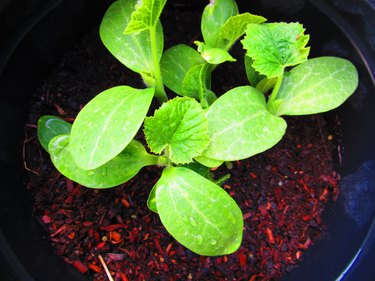
6. Water the plants
You'll need to water the plants regularly, especially if the weather is hot. Take care not to wet the leaves or you might find that your plant has fungal issues. It's better to water in the morning so that any moisture is evaporated by evening.
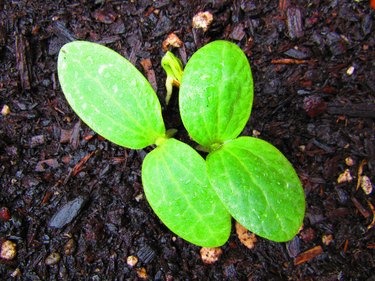
7. Watch for blossoms
Pumpkin blossoms will appear after 4 or 5 weeks with male blossoms first, followed by female blossoms. Generally, bees will do the pollination work, but you can hand-pollinate if you feel it is necessary using a small, dry toothbrush.
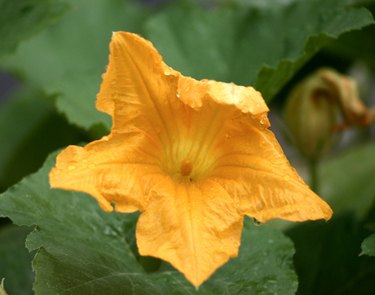
8. Harvest the pumpkins
How can you tell when your pumpkins are ripe? There are several ways. First, watch the calendar and when the time to maturity has passed, the fruits are likely to be ripe. Their color is also a sign. When the pumpkins reach the mature color on the seed packet, they are approaching maturity. The third way is to watch the leaves. As they start to die back, the pumpkins are approaching maturity.
Cut the stems with pruners. Don't yank or twist, as this may damage the plant.

9. Cure the pumpkins
You need to cure pumpkins once you harvest them. This drying process helps to thicken the skin and allows for better storage. If the weather is dry, leave the pumpkins outdoors to cure for about a week. Otherwise, cure them indoors in a warm, dry spot.
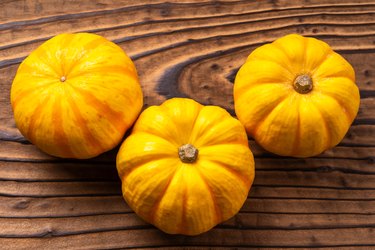
Mini Pumpkin Types
Here are five varieties of miniature pumpkins you might consider planting:
- Jack Be Little: One of the most popular small pumpkin varieties. They are less than a pound in weight and some 3 inches in diameter. They have a long shelf life and make lovely table decorations. It takes 75 to 90 days to maturity.
- Casperita: Small white pumpkin. These lovely little pumpkins, some 1 pound in weight, are wonderful for Halloween decorations. They also work well for Thanksgiving dinners since they taste like acorn squash. Count on 75 days from seeding to maturity.
- Gooligan: Another white pumpkin, around 1 pound in weight, these are slightly bigger, about 6 inches in diameter, and grow well on a trellis. The white skin can easily be painted with Halloween designs. They take some 90 to 100 days from seed to maturity.
- Bumpkin: Cute bright-orange pumpkins, only 2 inches by 3 inches and 1/4 pound in weight. They grow in a semibush shape and resist powdery mold. Harvest about 85 days from seed planting.
- Small sugar pumpkin: Want to use your miniature pumpkin for a pie? This is your variety. They are smaller than normal but larger than many minis at 7 inches in diameter. They are delicious and sweet. The seed package says 85 to 90 days, but friends say they take somewhat longer to mature.